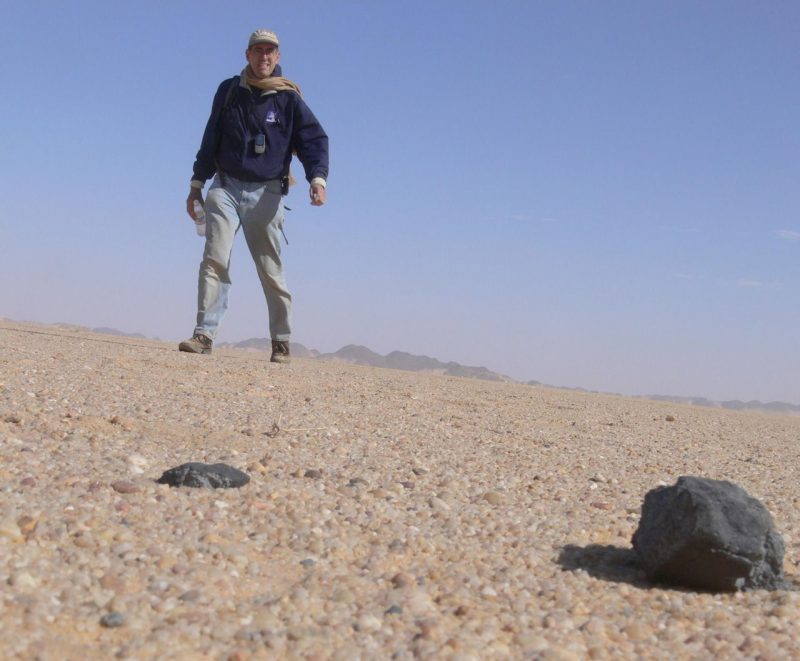
What part of an asteroid reaches the ground?
When a small asteroid enters Earth’s atmosphere from space, its surface is brutally heated, causing melting and fragmenting. So it’s been a mystery as to why space rocks survive and reach the ground as meteorites. A new study solves that mystery, using the fiery entry of asteroid 2008 TC3.
The peer-reviewed journal Meteoritics and Planetary Science published the study on August 4, 2022. Peter Jenniskens – of the SETI Institute and NASA Ames Research Center – is the lead author and a meteor astronomer. Jenniskens said:
Most of our meteorites fall from rocks the size of grapefruits to small cars. Rocks that big do not spin fast enough to spread the heat during the brief meteor phase. And we now have evidence that the backside survives to the ground.
An asteroid scattered meteorites over Sudan in 2008
In 2008, scientists detected an almost 20-foot (6-meter) asteroid called 2008 TC3 in space. Then, they tracked it for over 20 hours before it hit the Earth’s atmosphere. It created a bright meteor that disintegrated over the Nubian Desert of Sudan. The breakup scattered a shower of meteorites over a 4.3 x 18.6 miles (7 x 30 km) area. So Jenniskens collaborated with University of Khartoum professor Muawia Shaddad and his students to recover these meteorites.
Professor Shaddad explained:
In a series of dedicated search campaigns, our students recovered over 600 meteorites. Some were as big as a fist, but most no bigger than a thumbnail. For each meteorite, we recorded the find location.

A tumbling asteroid
The researchers conducted grid searches perpendicular to the asteroid path. They were surprised to find that the larger, fist-sized meteorites spread out more than the smaller meteorites. Then, teaming up with NASA’s Asteroid Threat Assessment Project (ATAP) at NASA Ames Research Center, they decided to investigate.
Darrel Robertson of ATAP is a theoretical astronomer. Robertson indicated:
While the asteroid approached Earth, its brightness flickered from spinning and tumbling. Because of that, asteroid 2008 TC3 is unique in that we know the shape and orientation of the asteroid when it entered Earth’s atmosphere.

Computer model shows entry into atmosphere
Robertson created a hydrodynamic model of the entry of 2008 TC3 into Earth’s atmosphere. The model shows how the asteroid melts and breaks up. He used the observed altitudes of meteor brightness and dust clouds to calibrate the altitude of phenomena recognized in the model.
Robertson then added:
Because of the high speed coming in, we found that the asteroid punched a near vacuum wake in the atmosphere. The first fragments came from the sides of the asteroid and tended to move into that wake, where they mixed and fell to the ground with low relative speeds.

Size and shape makes the difference
While falling to the ground, friction with the atmosphere soon stopped the smallest meteorites, falling close to the breakup point. The atmosphere had a harder time stopping larger meteorites, which fell further downrange. As a result, most recovered meteorites were found along a narrow 0.6-mile (1-km) wide strip in the asteroid’s path.
Robertson further commented:
The asteroid melted more and more at the front until the surviving part at the back and bottom-back of the asteroid reached a point where it suddenly collapsed and broke into many pieces. The bottom-back surviving as it did was because of the shape of the asteroid.

Larger meteorites spread out
No longer trapped by the shock from the asteroid itself, the shocks from the individual pieces now repulsed them. That sent these final fragments flying outward with much higher relative speed.
Jenniskens added:
The largest meteorites from 2008 TC3 spread out wider than the small ones, which means that they originated from this final collapse. Based on where they were found, we concluded that these pieces stayed relatively large all the way to the ground.
The location of the large meteorites on the ground reflects their location in the back and bottom-back part of the original asteroid.
The meteorites were different types of rocks
Cyrena Goodrich of the Lunar and Planetary Institute led a team of meteoriticists in the study. They determined the meteorite type of each recovered fragment in the large mass area.
According to Goodrich:
This asteroid was a mixed bag of rocks.
The researchers found that the different meteorite types were spread randomly on the ground, and therefore were also spread randomly in the original asteroid. Goodrich said:
That agrees with the fact that other meteorites of this kind, albeit on a much smaller scale, also contain random mixtures.
These results may also help scientists understand other meteorite falls. Asteroids are exposed to cosmic rays while in space, creating a low level of radioactivity and more near the surface. Jenniskens said:
From that radioactivity, we often find that the meteorites did not come from the better-shielded interior. We now know they came from the surface at the back of the asteroid.
Bottom line: We discovered and tracked Asteroid 2008 TC3 before it entered our atmosphere. The resulting meteor scattered meteorites over Sudan. After collecting and studying them, researchers found the meteorites came from the back of the asteroid.
Source: Bolide fragmentation: What parts of asteroid 2008 TC3 survived to the ground?











